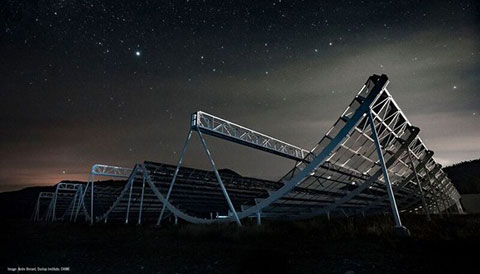The first "fast radio burst" detected by the Canadian CHIME radio telescope is a tantalizing hint of what’s to come.

McGill University
Over the course of a day, the radio sky sparkles with thousands of bursts that are briefly hundreds of millions of times more energetic than the Sun. But they’re so fleeting that astronomers miss them time and time again. In fact, since astronomers detected the first so-called fast radio burst more than a decade ago, they’ve only managed to spot 35 more. But all of that is about to change.
On the morning of July 25th, one such burst lit up a new array of radio telescopes called CHIME, nestled in the mountains of British Columbia. Given that the telescope has yet to even enter its finalized design (slated to occur sometime this fall), it’s a promising sign that CHIME — along with a series of other radio telescopes due to come online soon — might be able to spot several fast radio bursts a day in a feat that would truly revolutionize the field.
See, the bursts are a cosmic mystery. “There's no clear answer when it comes to fast radio bursts — and I think that's part of what makes them exciting.” says Emily Petroff (Netherlands Institute for Radio Astronomy). “There is this puzzle and there are a lot of pieces to put together to get the entire picture. But we haven't even laid out the edges of the puzzle yet.”
The issue is that so few of them have been detected. Astronomers often joke that there are more theories than actual fast radio bursts. It’s true: Today, there are 36 published bursts and 45 published theories. While those theories vary wildly, astronomers suspect that because fast radio bursts are extremely bright yet very distant, they could represent an entirely new class of astrophysical objects — one that just might open a new window on the cosmos.
The CHIME Advantage
Needless to say, scientists are anxious to piece together this great cosmic puzzle. And Petroff says CHIME will help astronomers lay down an entire edge. That’s because CHIME probes a different radio frequency than most other telescopes. Both the Parkes radio telescope in Australia and the Arecibo Observatory in Puerto Rico, for example, search for radio waves that emit radio waves at frequencies above 1 gigahertz. CHIME, on the other hand, will scour the skies at lower frequencies, searching for radio waves in the range of 400 to 800 megahertz — a frequency space that is mostly unprobed.
But CHIME’s greatest power might be its large field-of-view. The telescope isn’t a single dish, but instead consists of four 100-meter-long, semi-cylindrical antennas that can monitor a much larger patch of the sky than other radio telescopes. That’s crucial. Even though fast radio bursts supposedly wash across Earth thousands of times a day, they can come from any random point on the sky. In other words, astronomers have no idea where to look. But if they can analyze larger portions of the sky at once, then they have a better chance at catching one in the act. CHIME captures 200 square degrees at once — an area 400 times greater than that scoured by some of its competitors — and it looks at every part of the northern sky for roughly 10 minutes every day.
That said, astronomers aren’t sure how many fast radio bursts emit at lower frequencies. Depending on the answer to that question, early estimates suggested that the telescope could detect anywhere from 2 to 50 bursts a day. The fact that this first burst, called FRB 180725A, transmitted a signal as low as 580 megahertz is a good sign that the telescope might see numbers on the high end of that range: a potential downpour of bursts. “It was a very nice feeling that the whole project works, that there are actually fast radio bursts to be seen at these low frequencies and that CHIME can actually see them,” says Ziggy Pleunis (McGill University), one of the graduate students on the team.
That downpour might eventually provide insight into their origins. One theory, for example, suggests that the bursts are created when two neutron stars collide. If true, astronomers suspect that fast radio bursts will be brighter at lower frequencies than at higher ones, simply because neutron stars tend to be brighter at these frequencies. Should they see a similar trend in their data, it would lend weight to the argument that fast radio bursts are caused by the merger of these dense stellar cores.

NASA / CXC / M.Weiss
A Hint of What’s to Come
In fact, the CHIME team just might have a few more fast radio bursts already lurking within their data. Though Victoria Kaspi (McGill University), one of CHIME’s senior team members, was hesitant to say anything with certainty, given that the data still have to be vetted, she did verify that there are at least two more fast radio bursts whose emissions drop as low as 400 megahertz.
It’s another promising sign that CHIME might detect many fast radio bursts per day. If so, the number of puzzle pieces might soon outpace the number of possible theories, a change that can only help astronomers pin down these enigmatic objects. “We're just in the beginning stages of what I think will be a very eventful couple of years,” Petroff says.
 0
0









Comments
You must be logged in to post a comment.